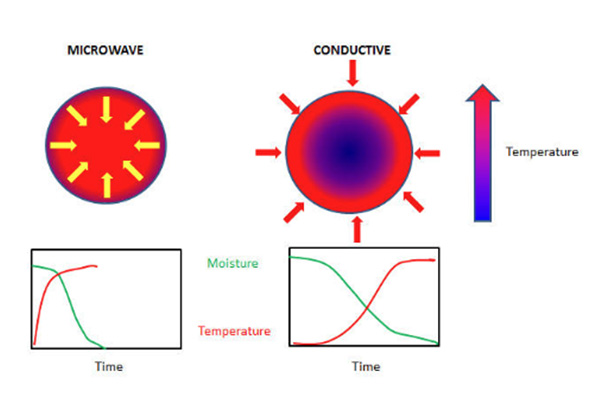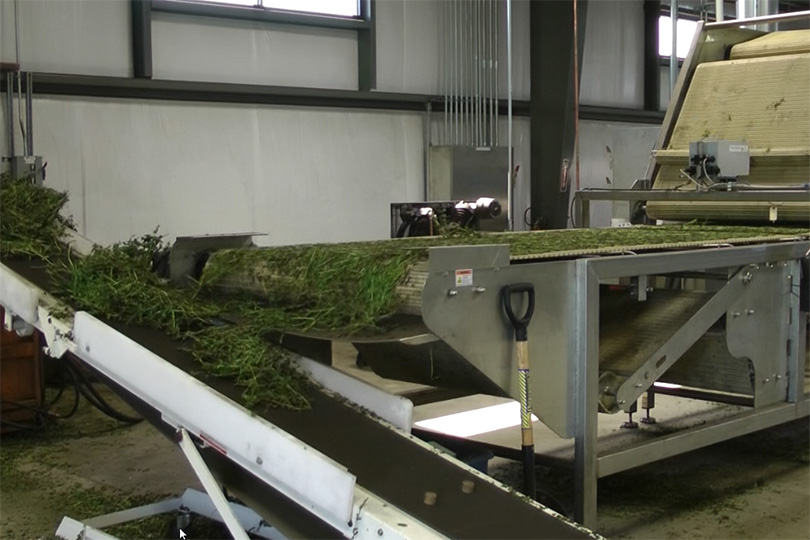Improve energy efficiency, reduce downtime, and scale production with solid-state microwave technology for thermal processing.
By Lori Tybon
Industrial heating powers a wide range of processes from drying powders and curing coatings to complex thermal reactions in food, chemical, and specialty material manufacturing. Yet many of the conventional systems still in use, like furnaces, rotary kilns, and convection dryers, struggle with inefficiency, uneven heat, and costly maintenance. As the pressure builds for manufacturers to cut energy use, reduce emissions, and improve process control, solid-state microwave technology is emerging as a smarter, high-performance alternative.
By delivering energy directly into materials, solid-state microwaves heat from the inside out, enabling faster, more uniform, and energy-efficient processing. Their real-time control capabilities and modular design make them adaptable to both batch and continuous operations across industries.
Across food, chemical, and advanced materials sectors, manufacturers rely on heat to transform raw inputs into finished products. However, traditional thermal systems introduce persistent challenges that limit performance:
Inefficient Heat Transfer
Combustion-based furnaces and electric heaters typically apply heat to the material’s surface. The energy must then travel inward via conduction, which is slow and inefficient, particularly for dense or moist materials. This not only increases energy usage but extends drying or curing times.
Uneven Temperature Distribution
Surface-based heating often leads to temperature gradients causing hot spots and cold zones within the same material. These inconsistencies can result in over-processed or under-processed areas, impacting quality and increasing scrap or rework rates.
High Energy Consumption
To compensate for inefficiencies and heat losses to air and equipment, traditional systems often consume far more energy than needed. This drives up operating costs and carbon emissions.
Maintenance Challenges
Furnaces, ovens, and rotary kilns commonly used to process powders and some liquids experience significant wear over time. Refractory linings, burners, and mechanical parts degrade under prolonged excessive heat exposure, resulting in costly downtime for repairs and replacements.
Throughput Bottlenecks
Slow heat transfer rates and inconsistent heating can significantly limit throughput. In both batch and continuous operations, these constraints create bottlenecks that reduce overall plant productivity. Scaling up often involves scraping and purchasing new, larger systems to accommodate increased throughput needs.

How Microwaves Heat
Microwaves are a form of electromagnetic (EM) energy, operating at higher frequencies than radio waves. When microwaves pass through materials with polar molecules, like water, the molecules attempt to align with the alternating electromagnetic field at millions of times per second. This rapid motion generates friction, which then creates heat. With properly designed systems, this form of heating excites water molecules throughout the entire volume of the material, making microwave heating more uniform and efficient.
From Magnetrons to Solid-State Control
Traditional microwave systems use magnetron tubes, the same type found in household microwaves. While capable of producing high power, they come with significant drawbacks:
Solid-state microwave systems replace magnetrons with semiconductor devices (like LDMOS or GaN transistors) and introduce transformative benefits:
Consistency Across Batches
Because solid-state microwave energy heats materials throughout their entire volume, the result is highly uniform thermal treatment. Hot and cold spots are minimized, improving product consistency and reducing thermal damage.
Lower Costs and Energy Use
Microwave energy is directed straight into the material—selectively heating the material to be processed and nothing else– eliminating the need to heat ambient air, tray surfaces, or large equipment. This makes the process far more energy-efficient than traditional convection, conduction, or radiant heat systems.
Higher Throughput
Volumetric heating speeds up drying and curing times significantly, allowing for increased output. Whether used in batch or continuous flow systems, solid-state microwave systems shorten cycle times and enable faster response to demand fluctuations.
Real-Time Process Control
Operators can fine-tune temperature, frequency, and power with high precision, making it easier to adapt to different product types or moisture levels. This level of responsiveness is particularly valuable in industries processing sensitive materials.

These advantages are supported by a growing body of research in powder and specialty food sectors. Microwave-assisted drying, particularly with solid-state generators, has demonstrated the possibility of improving energy efficiency from 50% to upwards of 90% making the process more sustainable. In powdered food products like whey protein and nutritional supplements, microwave drying has enabled processors to reach <1% moisture content while preserving nutrients, flavor, and texture. Pilot-scale implementations have also shown improved throughput and minimized clumping or scorching—common issues in high-temperature conventional drying.
Solid-state systems’ ability to modulate power and frequency on the fly has been especially beneficial in drying materials with uneven or layered moisture content. The result is better flowability, extended shelf life, and higher overall product quality.
Solid-state microwave technology is transforming the limitations of traditional thermal systems into opportunities for greater efficiency, control, and quality. Industries adopting this technology can expect:
By transitioning to solid-state microwave systems, manufacturers position themselves at the forefront of innovation where energy use, product quality, and process control are optimized by design.
As more industries validate these benefits through pilot programs and full-scale adoption, the case for smarter, cleaner, and more reliable heating continues to grow. Solid-state microwave technology isn’t just a replacement, it’s a next-generation solution reshaping the future of industrial processing.

About the Author:
Lori Tybon serves as Marketing Director at Crescend Technologies where she leads strategic marketing initiatives for the company’s solid-state RF microwave product line. With extensive experience in B2B marketing and communications, she focuses on positioning innovative industrial technologies for growth and market leadership.
Contact: 1-800-USA-MADE (1-800-872-6233)
Read more from the author:
Breaking Rocks with Less Energy: The Role of Microwaves in Mining | Bulk Powder & Solids, March 24, 2025
From tradition to transformation Sequoia Brass & Copper has stood for excellence in American manufacturing. In this episode, we sit down with Kim MacFarlane, President of Sequoia Brass & Copper, to hear the inspiring story of a family-owned company founded by her father, built on craftsmanship, trust, and a relentless commitment to quality. Kim shares how she’s guided the company through the challenges of modern industry while honoring its heritage, and how the next chapter will be carried forward by her son Kyle. This is more than a story of brass and copper; it’s about resilience, innovation, and the enduring strength of family legacy. If you’ve ever wondered how tradition can meet the demands of today’s industry hit play and be inspired.